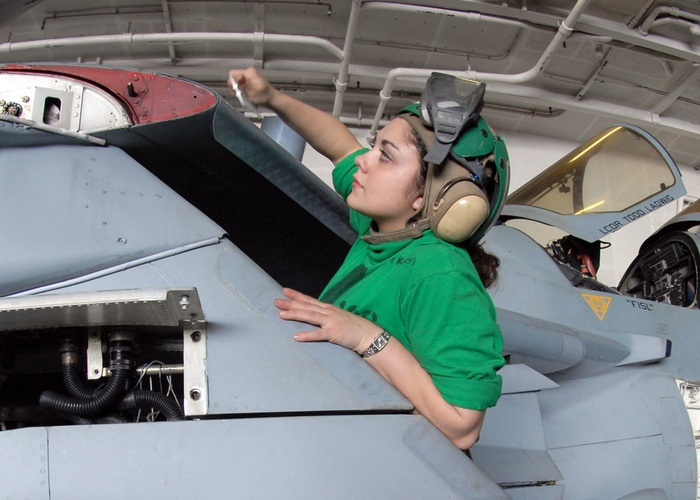The Near-Peer Problem: How To Create Standoff in Aerial ISR
In the cult-classic, iconic Cold War movie “Red Dawn,” the young guerrillas are talking to the world-weathered Lt. Col. Andrew 'Andy' Tanner, who had just been shot down. They asked him what started the war. His response was along the lines of that the two biggest kids on the playground were eventually going to come to blows. Is this entirely accurate? We all hope not. But the good Colonel was certainly correct about one thing: Russia and the U.S. are two of the biggest kids on the playground, and we have had more than our fair share of close calls over the years.
In a more modern vernacular, the large comparable nations to ourselves are considered ‘near-peer’ threats. These nations are not altogether friendly to us and have comparable military capabilities. Let’s take a look at what these threats are and how the U.S. is poised to address these threats.
How are Near Peer Weapons different from previous threats?
Okay, so this question isn’t exactly accurate to what we are getting at here. Instead, how are near-peer nations more dangerous than in previous years? Or are they?

The most obvious threat at the moment is a conflict with Russia, as the conflict between Russia and Ukraine continues to drag on. This conflict is a great case study of what a land and air conflict would look like in Eastern Europe if the U.S. became more actively involved and a modern land conflict, in general, using conventional weapon systems. Here’s a synopsis of where our near-peer competitors are with existing systems.
Near-peer threat weapons refer to military technologies possessed by adversaries considered close in capability to a particular military force. These weapons systems can present unique challenges compared to previous armed conflicts.
One key difference is the level of technological sophistication. Near-peer adversaries have access to advanced technologies that may rival the defending force. This can include advanced missile systems, cyber capabilities, electronic warfare tools, and other cutting-edge technologies.
Another aspect is the potential for strategic competition. Near-peer conflicts often involve geopolitical considerations and can escalate more quickly due to the presence of advanced weaponry. The risk of a major confrontation involving multiple domains like cyberspace and space is higher. Our armed forces, from the Joint Chiefs down, must continue to address these threats.
Additionally, near-peer adversaries may employ real threat strategies that exploit the vulnerabilities of modern interconnected defense systems. This could involve targeting critical infrastructure, disrupting communication networks, or using cyber attacks to undermine military capabilities.
In essence, dealing with near-peer weapons requires a comprehensive understanding of both traditional and emerging threats and the ability to adapt quickly to rapidly evolving technological landscapes. It's a game of strategy and agility in the face of formidable opponents.
Accelerating Modernization to Defeat Emerging Threats
While nobody should relish the fact that war exists and is in progress all over the globe as we speak, it is a great way to identify what our near-peers have had in development for their forces. From a strategic perspective, there are countless lessons to learn by dissecting the fighting in threatened lands, evaluating the extent of their resources, and the success of using their country's weapons.
As the threats come to light from government forces that oppose the U.S., our development strategy shifts to meet the threats posed by our adversaries with certain levels of parity, or near-parity, with the U.S. We use this to formulate a strategy to confront near-peer threats, should it come to that.
So, how serious is this? According to the DoD, the near-peer threats we see today are at their highest since the Cold War, which ended over three decades ago. This is certainly alarming when considering how serious the Cold War was in the grand scheme.
Here’s the stark, cold truth: our near-peers are advancing their technology as fast as they can. We are still the benchmark for the world to copy, but our adversaries are designing, iterating, and building as fast as possible to keep up and outpace us if possible.
Who Are Our Near Peer Adversaries?
This is a short list. Russia and China represent the two main threats in this arena. The other nations with that military capability for manpower strength are not our adversaries, namely, India.
China
China has been a long-time competitor on the global stage. Still retaining their alignment as a communist nation, they are cultural opponents of the United States. But they are also a military threat, regarding their long-standing sympathies toward North Korea and hostility toward Taiwan, a major ally of the U.S. Taiwan is also a major trade partner of the U.S., although they are certainly not aligned only with America.
For several reasons, China is often considered a near-peer threat to the United States. Firstly, in terms of economic power, China has experienced rapid growth and has become the world's second-largest economy. This economic strength translates into geopolitical influence and the ability to invest in military capabilities.

Speaking of military capabilities, China has significantly modernized its military forces. They have developed advanced technologies, including hypersonic missiles, advanced cyber capabilities, and a robust naval presence. This military modernization raises concerns about China's intentions and its ability to project power in the Asia-Pacific region, potentially challenging U.S. military dominance. One of the major shortcomings of the Chinese military is the lack of a dedicated and robust non-commissioned officer corps, which is one of the hallmarks of the American military. The NCO corps is the system that allows the U.S. military to function as well as it does, not constantly relying on decision-making from the commissioned officer corps.
Moreover, China's assertive actions in regional territorial disputes, such as in the South China Sea, have heightened tensions with neighboring countries, and the U.S. China's increasing global influence through initiatives like the Belt and Road Initiative also contributes to its status as a geopolitical competitor.
Russia
Russia is considered a near-peer threat to the United States for several reasons. One of the primary factors is its military capabilities. Despite economic challenges, Russia maintains a significant and modernized military, including nuclear capabilities. The possession of a large and diverse nuclear arsenal makes Russia a major nuclear power and a key player in global strategic stability.

Russia has also invested in modernizing its conventional military forces, including advanced missile systems, cyber capabilities, and electronic warfare capabilities. These developments contribute to its ability to project power and influence in its immediate region and beyond.
Additionally, Russia has demonstrated a willingness to challenge the interests of the United States and its allies. This includes involvement in conflicts such as the annexation of Crimea in 2014 and its support for separatist movements in Eastern Ukraine. Russia's military interventions in Syria and its efforts to expand its influence in the Middle East and Africa have also raised concerns. Syria was more or less the middleman in a proxy war between the U.S. and Russia around 2014-2015 when the United States was headhunting ISIS. Of course, this is a gross understatement of what the conflict is, but it is more or less the catalyst for a series of escalations since 2015 with Russia.
In the realm of cybersecurity, Russia is often accused of engaging in cyber operations that target the U.S. and its allies. This includes activities such as election interference, cyber espionage, and disruptive cyberattacks.
Core Technologies for Future Battlefield Networks and Command Posts
The future is bright for emerging technologies in battlefield networks and command posts. Army command structure relies heavily on the technologies used in battlefield networks and command posts, but a lot of that technology hasn’t changed much since World War II.
The future battlefield networks and command posts (CPs) are likely to rely on advanced technologies to enhance communication, coordination, and overall operational effectiveness. Some core technologies for future battlefield networks and CPs may include:
- 5G Technology: The deployment of 5G networks will significantly enhance communication speeds and connectivity, allowing for real-time data transmission, low latency, and improved overall network performance on the battlefield.
- Artificial Intelligence (AI): AI can be used for data analysis, predictive modeling, and decision support. Machine learning algorithms help process vast amounts of information quickly and provide actionable insights to commanders. This also largely eliminates the potential for human error.
- Edge Computing: By processing data closer to the source (at the "edge" of the network), edge computing reduces latency and enhances the speed of decision-making in dynamic battlefield environments.
- Cybersecurity Solutions: Given the increasing reliance on digital technologies, robust cybersecurity measures will be crucial to protect sensitive military information and prevent cyber threats and attacks.
- Advanced Encryption: As data security is of utmost importance, using advanced encryption techniques ensures the confidentiality and integrity of communications and data transmitted across the network.
- Satellite Communication (SATCOM): SATCOM systems provide reliable global communication capabilities, enabling military forces to stay connected in remote or challenging environments.
- Autonomous Systems: Unmanned aerial vehicles (UAVs), ground robots, and autonomous vehicles can be integrated into the network to perform various tasks, such as reconnaissance, surveillance, and logistics, reducing the risk to human personnel.
- Blockchain Technology: Blockchain can enhance the security and transparency of data transactions, ensuring the integrity of information and preventing tampering or unauthorized access.
- Multi-Domain Operations (MDO): Integrating capabilities across land, air, sea, space, and cyberspace domains to create a more comprehensive and interconnected operational environment.
- Augmented Reality (AR) and Virtual Reality (VR): AR and VR technologies can be used for training, simulation, and enhancing situational awareness for commanders and personnel in the field.
- Quantum Computing: While still in the early stages, quantum computing has the potential to revolutionize data processing and cryptography, providing new ways to solve complex problems and enhance the security of communication systems.
How ISR Aircraft Shift The Battlefield In Our Favor
ISR aircraft are the eyes in the sky that are invaluable to all combatant commanders in the battlespace.
MC-12W Liberty
The MC-12W Liberty is a special mission aircraft operated by the United States Air Force (USAF). It is a modified version of the Beechcraft King Air 350ER turboprop aircraft used for (ISR) missions. The MC-12W carries a sophisticated sensor suite, including electro-optical/infrared (EO/IR) cameras, radar, and signals intelligence (SIGINT) equipment.

The fleet of MC-12Ws has shrunk a lot over the years, and all of the remaining aircraft are assigned to the Oklahoma Air National Guard.
E-11A Battlefield Airborne Communications Node
The E-11A BACN system functions as an airborne, high-altitude gateway.
This allows real-time, seamless communication between ground soldiers, aircraft, and other assets, irrespective of the communication technology or network they are utilizing. When topography or other variables impede line-of-sight communication or compromise the efficiency of conventional communications systems, the BACN system is especially helpful.

For military personnel in the field, it enables better coordination, increased situational awareness, and enhanced operational efficacy. The Air Force has larger endeavors to accomplish information dominance and preserve battlefield superiority in contemporary battles that rely heavily on the BACN system.
ARTEMIS Program
The newest instrument in the Army's aerial ISR arsenal isn't even one of their own. The ARTEMIS platform is run and owned entirely by private companies. Rather, Leidos, a well-known defense contractor, owns and runs it. Leidos had overseen the entire project from start to finish to provide the US Army with an ISR advantage.
How Greenwood Aerospace
As the boundaries of ISR aviation continue to expand and the demands of modern conflicts and humanitarian crises become more intricate, the need for forward-thinking solutions has never been greater. Whether you're a military decision-maker seeking to enhance operational effectiveness or a visionary seeking to contribute to a safer world, Greenwood Aerospace can provide the aviation services your program needs.
Give us a call or start an online quote to see how our services are the right fit for you and your operation!


.svg)


.png)


